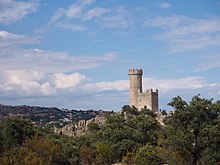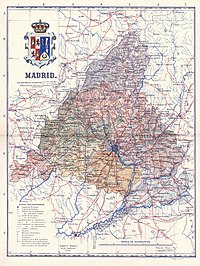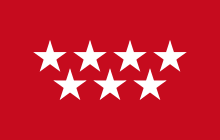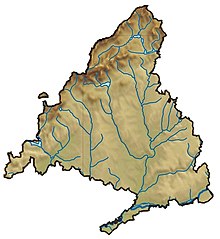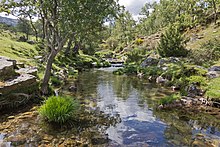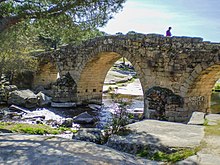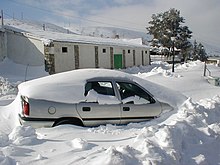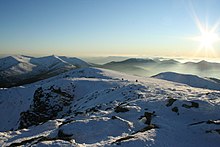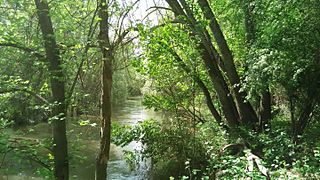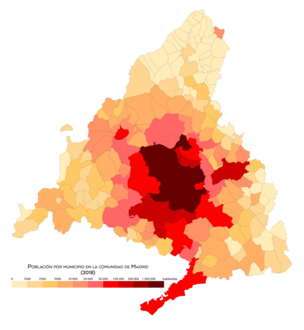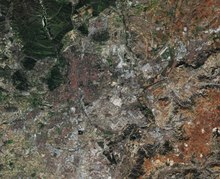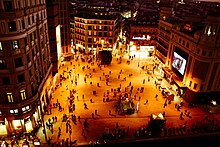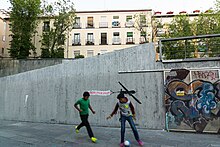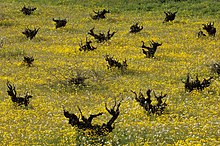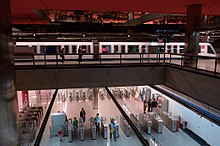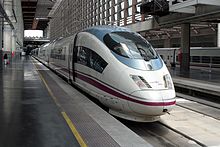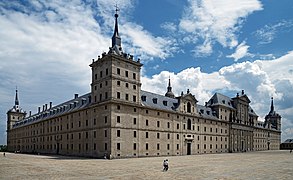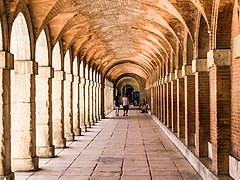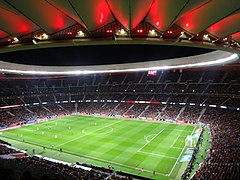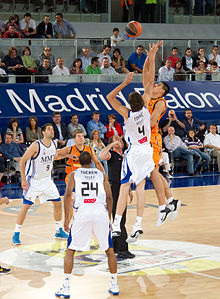Madrid's community
The Community of Madrid is a Spanish autonomous community located in the interior of the Iberian Peninsula, in the South Subplateau of the Central Plateau. It borders the provinces of Ávila and Segovia in Castilla y León, as well as those of Toledo, Guadalajara and a small part of Cuenca in Castilla-La Mancha. The Community of Madrid is uniprovincial, so there is no council. Its capital, Madrid, is also the capital of Spain. The population amounts to 6,751,251 inhabitants (INE 2021) and is mostly concentrated in the metropolitan area of Madrid.
It is the third autonomous community in terms of population and the most densely populated. It has a central position in the transport network in Spain. In 2018, Madrid's GDP represents 19.2% of the national GDP. Likewise, it has artistic and natural heritage, with four World Heritage assets: the Monastery and Site of El Escorial, the University and the historic center of Alcalá de Henares, the Cultural Landscape of Aranjuez and the Landscape of Light in Madrid.
The formation of the autonomous community was preceded by an intense political debate, in the pre-autonomous context of the late 1970s. The province was conventionally included in the region of Castilla la Nueva since the xix, together with the provinces of Cuenca, Guadalajara, Ciudad Real and Toledo. At first, the possibility was raised that it would form part of an autonomy together with these provinces, today part of Castilla-La Mancha, although with a special statute, given its special conditions as it is the capital of the State. In 1981 it was resolved that the province of Madrid would not be included in a multi-provincial community and the creation of a uniprovincial autonomous community was agreed, approving by Organic Law on February 25, 1983 its Statute of Autonomy, which entered into force on March of that same year.
History
The history of the Community of Madrid is very recent. The province was administratively constituted in the XIX century and, at the end of the XX, is configured as a uniprovincial autonomous community. However, there are some previous historical milestones, decisive for the definition of the current profile of the autonomous community:
- The presence of human settlements, of great importance and extension, in history;
- The appearance of Complutum (Alkah of Henares) in the Roman period;
- The defensive character that acquires the territory of Madrid in the Andalusian period and the role of Majrit (“Madrid”) in the defense of Toledo;
- The constitution of the council of the Earth of Madrid during the Reconquista, the first great embryo of the subsequent administrative reality;
- The designation of the Madrid villa as a capital during the Renaissance, in which it constitutes the second and most decisive embryo;
- The Metropolitan Expansion of the Century XX.which is transcendental for the formation of the present autonomous community.
Among all these milestones, the capital stands out as the one with the greatest historical determination, since it is at the origin of the province of Madrid, established within the framework of the provincial division of Spain in the XIX. To this fact is added, in the XX century, the metropolitan condition of Madrid, a key aspect for its segregation from the old region of Castilla la Nueva, in which Madrid was integrated, given the strong social, economic and demographic imbalances that the metropolitan area of Madrid introduced, and its configuration as a uniprovincial community.
Prehistory, Roman times and Visigothic times
The current territory of the Community of Madrid was populated since the Lower Paleolithic, mainly in regards to the interfluvial valleys of the Manzanares, Jarama and Henares rivers, where abundant and rich archaeological sites have been found. Among the most important vestiges that have been found, the Ciempozuelos bell-shaped vase stands out, which has given its name to a special type of ceramic (dating from the Early Bronze Age, between 1979 BC and 1970 BC). Rock paintings and engravings have also been discovered in La Pedriza, in the municipality of Manzanares el Real, and in the Reguerillo cave, in Patones.
During the Roman Empire, the region was integrated into the province of Citerior Tarraconense, except for the southwestern part, in Alberche, which belonged to Lusitania. It was crossed by two important Roman roads, the XXIV-XXIX road (from Astorga to Laminium) and the XXV (from Augusta Emerita to Caesaraugusta), and had some important cities. The city of Complutum (Alcalá de Henares) reached a certain importance until the Late Empire, while Titulcia and Miaccum, at the foot of the mountains, stood out as crossroads.
In the Visigothic period, the region lost all importance. Its population dispersed into small villages and even Complutum fell into decline. Alcalá de Henares was designated the episcopal seat in the V century, by order of Asturio Serrano, Archbishop of Toledo, but this fact did not It was enough to restore its lost splendor.
Al-Andalus
The center of the peninsula was one of the most sparsely populated regions of al-Andalus until the XI century, when it began to rise as a military enclave of great strategic importance. The Muslims put up a defensive system of fortresses and watchtowers, with which they tried to stop the advance of the Christian kingdoms, throughout the current territory of the autonomous community.
The territory constituted an area without its own personality within the Middle March with center in Toledo, and in which some Andalusian castles or fortifications (ḥuṣūn) were erected, around some of which, like Madrid, it ended up forming a city (madīna):
The fortress of Majrit ("Madrid") was erected on an indeterminate date between the years 860 and 880, as a ribat, a walled enclosure where a community lived both religious and military, in what constitutes the founding core of the city. It soon stood out as the fortification with the greatest strategic value in the defense of Toledo, above Talamanca de Jarama and Qal'at 'Abd al-Salam (Alcalá de Henares), the other two most important military enclaves in that defensive system.
Around the main headwaters, in charge of defending the Manzanares, Jarama and Henares river paths, respectively; complementary fortifications were built, such as the case of Qal'at Khalifa (Villaviciosa de Odón, controlling the route of the Guadarrama river).
Probably in the x century, under the initiative of the Umayyad, a network of watchtowers more northerly was also erected that allowed surveillance of the passes; Of which the existence of those of Venturada, El Vellón and El Berrueco, in the Jarama area, and those of Torrelodones and Collado de la Torrecilla, in the area of the Sierra de Hoyo de Manzanares, are known. These watchtowers they communicated with each other through smoke signals, when alert situations occurred.
In 1083, King Alfonso VI took the city of Madrid and two years later entered Toledo. For its part, Alcalá de Henares succumbed in 1118, in a new annexation of the Kingdom of Castile.
Christian repopulation
The new lands conquered by the Christians broke up around various domains, as a consequence of a long process of repopulation (XI centuries a XV), in which the feudal or ecclesiastical lords and the different councils with real power to repopulate came into conflict.
First of all, in 1118 Alcalá de Henares and its entire Community of Villa y Tierra will be reconquered. In 1135 the Complutense Land will receive a compendium of laws or charters, called Fuero Viejo. This will partly compensate for the integration of the Complutense Diocese into the Archbishopric of Toledo in 1099. In 1223, Archbishop Rodrigo Ximénez de Rada made a modification of these charters, in what has come to be called Fuero Extenso. It will be in 1509, when Cardinal Cisneros will create a new and updated jurisdiction, the Fuero Nuevo, which will be in force until the end of the Old Regime. These laws gave complete legal autonomy to Tierra de Alcalá.
In the XIII century, Madrid retained, like Alcalá, its own legal personality, primarily with the Old law and later with the Royal Law, granted by Alfonso X in 1262 and ratified by Alfonso XI in 1339. Buitrago del Lozoya, Alcalá de Henares and Talamanca de Jarama will stand out for their important repopulation capacity until that century.
La Tierra de Alcalá, administrative area where the previously mentioned privileges governed, was made up in its last phase (Fuero Nuevo) by the following municipalities: Ajalvir, Camarma de Esteruelas, Daganzo de Abajo (or Daganzuelo, today uninhabited), Torrejón de Ardoz, Valdemora, Arganda, Ambite, Anchuelo, Bilches or Vilches, Campo Real, Carabaña, Corpa, Los Hueros, Loeches, La Olmeda, Orusco, Perales de Tajuña, Pezuela de las Torres, Querencia, Santorcaz, Los Santos de la Humosa, Tielmes, Torres de la Alameda, Valtierra, Valmores, Valverde de Alcalá, Villar del Olmo, Valdilecha and Villalbilla.
Around the current capital of the community, an administrative territory called Tierra de Madrid was established, the first germ of the province, which extended, at its ends, to the current municipalities of San Sebastián de los Reyes, Cobeña, Las Rozas de Madrid, Rivas-Vaciamadrid, Torrejón de Velasco, Alcorcón, San Fernando de Henares and Griñón.
This council had numerous disputes with Segovia, at that time one of the most influential cities in Castilla, for control of Real de Manzanares, a vast region, which was finally ceded to the House of Mendoza. The Community of city and land of Segovia had converted in its sexmo of Casarrubios, in the valleys of the Guadarrama and Perales rivers, the alfoz of the old Islamic medina of Calatalifa (in the current municipality of Villaviciosa de Odón).
The capital city
The Castilian monarchy began to show a special predilection for the center of the peninsula, attracted by its abundant forests and hunting grounds. El Pardo was a place very frequented by kings, since the time of Henry III (XIV century). Likewise, the Catholic Monarchs promoted the construction of the Royal Palace of Aranjuez. In the XVI century, San Lorenzo de El Escorial was added to the list of Royal Sites of the current province.
The town of Madrid itself, which was part of the group of eighteen cities with the right to vote in the Cortes of Castile, hosted the Cortes of the Kingdom on numerous occasions. At the same time, it served as the residence of various monarchs, including Emperor Charles V, who reformed and expanded its fortress. In addition to the growing sociopolitical influence of the region, in the XVI, the cultural focus of the University of Alcalá de Henares, which opened its doors in 1508 at the behest of Cardinal Cisneros.
In 1561, King Felipe II placed the capital of his empire in Madrid, in what can be considered the second embryo —and perhaps the most decisive— for the subsequent configuration of the province of Madrid.
With the capital status, a framework of economic subordination was imposed on the lands adjacent to the town of Madrid, which even went beyond the current limits of the Community of Madrid. An extension of the jurisdiction of the House and Court Hall of Mayors (from five to ten leagues around it) was also promoted, in an attempt to articulate a region around the capital.
But it was still a long way from an authentic administrative reality, especially considering that the State of the Old Regime coexisted with the existence of numerous stately jurisdictions, both secular and ecclesiastical. Among the former, there were large estates, such as the Real de Manzanares —in the hands of the Mendozas— and others of small dimensions, such as the estate of Valverde de Alcalá. Among the latter, there were monastic jurisdictions (such as the Cartuja de El Paular), secular clergy (such as the extensive possessions of the Archbishopric of Toledo) and military orders (the case of the Commander of Castile of the Order of Santiago, which was occupied by Valdaracete, Villarejo de Salvanés and Fuentidueña de Tajo).
The Enlightenment

In the 18th century the administrative dismantling of Madrid lands was not corrected either, despite some attempts. In the time of Felipe V, the figure of the Municipalities was created, on a national scale, with political-administrative power. However, the Municipality of Madrid did not solve the root problem and the current province continued to be fragmented into several domains, although the processes when executing centralized projects were streamlined.
The districts of Colmenar Viejo and Buitrago del Lozoya corresponded to Guadalajara, as well as the lordship of Real de Manzanares, largely coinciding with the current region of the Sierra de Guadarrama. Segovia extended its domains to the north and west of the current province of Madrid, while Toledo occupied the east, with Alcalá de Henares and Chinchón as prominent nuclei. Casarrubios, in the current province of Toledo, and Zorita de los Canes, in Guadalajara, depended on Madrid.
This territorial dispersion affected processes as basic as the supply of Madrid, which had skyrocketed its population to become the most inhabited city of the monarchy. The effect was drastic: while the town of Madrid absorbed a greater volume of income from the whole country, its adjoining territory —in the hands of noble houses and ecclesiastical power or under royal influence— tended to become impoverished, with no possibility of develop a socioeconomic fabric in accordance with the needs of the capital.
Another problem that the capital revealed was the lack of infrastructure. The network of roads of the Submeseta Sur had its center in Toledo and a network had to be articulated to guarantee the supply of the city. The radial structure of Spanish communications dates from the 18th century, which has its nerve center in the city of Madrid.
Throughout the 18th century, the town of Madrid was transformed with major urban works, in step with the currents illustrated. The work of Carlos III stands out, who endowed the city with some of its most beautiful buildings and monuments, while promoting the creation of social, economic and cultural institutions, which still survive.
The town of Madrid closed the 18th century with 156,672 inhabitants (before becoming the capital, the population was estimated at around 15,000 residents), according to the census carried out in 1787, the first, officially, carried out in the city.
From province to autonomous community
The territory of the Community of Madrid roughly reached its current territorial limits in 1833 with the division of Spain into provinces, one of which was Madrid. In this division, the province was attached to the region of Castilla la Nueva, which, like the rest of the regions, constituted only a classification, lacking any administrative body or institution. Along with that of Madrid, the provinces of Ciudad Real, Cuenca, Guadalajara and Toledo were included in Castilla la Nueva. A change in the limits of the province after the territorial division of 1833 would affect the small municipality of Valdeavero, of 19 km², until then belonging to the province of Guadalajara, which became part of the province of Madrid in 1850.
In the XX century, during the pre-autonomous process of the late 1970s, in the former region of Castilla la Nueva, the fear reappeared that the special economic and demographic conditions of Madrid were a factor of imbalance, so finally, the province of Madrid was configured as a uniprovincial autonomous community. It was the last community to be established.
For their part, the provinces of Ciudad Real, Cuenca, Guadalajara and Toledo (which belonged to Castilla la Nueva), together with that of Albacete (which was integrated into the Region of Murcia), constituted the autonomous community of Castilla- The stain.
The Autonomous Community of Madrid Statute was approved on March 1, 1983. The province of Madrid was established as an autonomous community under Organic Law 3/1983, of February 25 (BOE 1-3-83). Since June 1995, the Autonomous Community of Madrid has been called the "Community of Madrid" because the initials CAM are the same as those of the Caja de Ahorros del Mediterráneo (of Alicante), which won the lawsuit, arguing that in the Valencian community there was confusion between both acronyms when reading the national newspapers. The people of Madrid were not called to the polls to approve or reject the autonomous community proposal.
Madrid was chosen as the capital of the community, although different initiatives have emerged for other cities to become the capital. This is the case of Alcalá de Henares, which officially presented its candidacy in the early 1980s and, more recently, of Getafe, which in 2006 announced its aspiration to wrest the title of capital from the city of Madrid.
Since its creation, eight regional presidents have been elected: Joaquín Leguina (1983-1995), from the PSOE; and the rest belonging to the PP, which are: Alberto Ruiz-Gallardón (1995-2003), Esperanza Aguirre (2003-2012), Ignacio González (2012-2015), Cristina Cifuentes (2015-2018), Ángel Garrido (2018-2019), Pedro Rollán (2019) and Isabel Díaz Ayuso (2019-present).
Symbols
Law 2/1983, of December 23, on the flag, shield and anthem of the Community of Madrid defines and regulates the symbols of the Community of Madrid:
Flag
 |  |  |  |  |
The Madrid flag takes the crimson red background of the banner of Castile. The seven stars, which symbolize the constellation of Ursa Minor, come from the shield of the Earth of Madrid, a council formed at the time of the Reconquest. The five points of the stars represent the five provinces bordering Madrid (Ávila, Cuenca, Guadalajara, Segovia and Toledo). The seven stars are aligned in two rows: four are located on the top and the remaining three on the bottom. Different municipalities that were part of the old council of the Land of Madrid incorporate them in their heraldic shields. This is the case of Villa de Madrid and Las Rozas de Madrid, which integrated them until 1995, when the town hall of Roceño designed a new coat of arms. Populations located under the influence of this council also include the seven stars on their shields (Guadarrama, Valdemorillo or Fresno de Torote). The Tres Cantos shield also incorporates them, although, in this case, not as a reflection of its belonging to the council of the Land of Madrid, but in clear reference to the symbology of the autonomous community. It is the youngest municipality in the province, established in 1991 —when it was separated from Colmenar Viejo—, eight years after the flag and shield of the Community of Madrid were approved. Popularly, the seven stars are known as the seven gateways to Madrid.
In Law 2/1983, of December 23, on the Flag, Coat of Arms and Anthem of the Community of Madrid of the Madrid Statute of Autonomy, the reason for the crimson red is specified:
The flag of the Community is crimson red. Madrid thus indicates that it is a Castilian people and that Castellana has been its history, although obviously the economic and population development has been diverse. The Community of Madrid, formed in many cases by towns and municipalities that belonged to the Castellana Communities bordering it, thus expresses one of its essential features. The provision contained in article 32.3 of the Statute of Autonomy was only a reflection of those. The Law incorporates this symbol. The seven stars, coming from the coat of arms of the villa of Madrid, are also susceptible to being extended to the rest of the Autonomous Community, to cater especially to the two legends that give them origin.(...)
Shield
The coat of arms of the Community of Madrid is described heraldically in Annex 2 of Decree 2/1984, in the following terms:
(...) of a single barracks of gules and in it, of gold, two castles paired, almonds, donjonados, cleared of azur and sable mampostates, surmounted in the chief for seven stars of silver, placed four and three. To the bell, royal crown, closed, which is a circle of gold engraved with precious stones, composed of eight blossoms of acant leaves, visible five, interpolated with pearls and of whose leaves come up diadem paths added of pearls, which converge in a world of sugar, with the semi-meridian and the equator of gold, added to the golden cross. The crown, lined with gules.
Likewise, the reason for the paired castles is also specified:
(...) The golden castles on the edges of the Scottish shield also collect the most characteristic Spanish symbol. The two neighbouring communities look at them as emblems. The fact of being paired symbolizes the claim of the Community of Madrid to be a link between the two Castiles, founding the fundamental symbol of one and the other, while it comes to project its own extensive complexion to the precise limits of the five provinces that embrace it: Toledo, Guadalajara and Cuenca, belonging to Castilla-La Mancha; Segovia and Ávila, members of Castilla-León.
Anthem
The lyrics are the work of the philologist and poet Agustín García Calvo and the music of the composer Pablo Sorozábal Serrano, who did it at the personal request of Joaquín Leguina, president of the Community of Madrid,. The composition is the official anthem of the Community of Madrid since December 24, 1983, the date of its publication in the Official Gazette of the Community of Madrid.
The text consists of three stanzas:
Geography
| Northwest: Segovia | North: Segovia | Northeast: Guadalajara |
| West: Avila |  | This: Guadalajara |
| Southwest: Toledo | South: Toledo | Sureste: Cuenca |
The autonomous community has an area of 8021.80 km². Its limits describe an approximate equilateral triangle, in which its base is on the border with the province of Toledo, to the south, and its upper vertex in the port of Somosierra, to the north. The municipal term of Aranjuez breaks this triangular shape, like an appendix that enters the province of Toledo. Outside this triangle, surrounded by the provinces of Ávila and Segovia, is the Dehesa de la Cepeda, an enclave that belongs to the Madrid municipality of Santa María de la Alameda. The region is located in the center of the Central Plateau, in the northern part of the South Subplateau, between the Central System (to the north and northwest) and the Tagus River (to the south and southeast). It limits to the north and west with Castilla y León (provinces of Segovia and Ávila) and to the east and south with Castilla-La Mancha (provinces of Toledo, Guadalajara and Cuenca). There is a tiny enclave known as Los Barrancos and La Canaleja, belonging to the municipality of Torrejón del Rey (province of Guadalajara) which, although geographically located within the Community of Madrid, is not belongs to the region.
Nature
Despite the existence of the great urban pressure that implies the existence of more than 6 million people in such a small space, the Community of Madrid still preserves some remarkably intact and diverse habitats and landscapes. Madrid is home to mountain peaks that exceed 2,000 meters above sea level, holm oak meadows and low plains. There are three types of landscapes in the Community of Madrid: alpine meadows and pine forests in Guadarrama, Mediterranean forests and meadows in the flatter north, and scrub steppe in the extreme southeast of the region.
The slopes of the Sierra de Guadarrama are covered with dense forests of Scots pine and Pyrenean Pine. The Lozoya Valley supports a large colony of black vultures, and one of the last bastions of the Iberian imperial eagle in the world is located in the regional park of the Middle Course of the Guadarrama River and its surroundings, in the meadow hills, between the mountains from Gredos and Guadarrama. The possible recent detection of the existence of the Iberian lynx in the area between the Cofio and Alberche rivers is a testimony of the biodiversity of the area. The presence of the Iberian wolf in the Sierra Norte de Madrid, near Somosierra, is also notable.
Taking advantage of the orography, there are several reservoirs and dams in the region, being those of Santillana and El Atazar the largest.
Relief
The community of Madrid has an altitude that varies between 430 m above sea level in the last section of the Alberche river in the municipality of Villa del Prado and 2428 m at the Peñalara peak. The relief of the Community of Madrid is defined by two large units: the mountains and the Tagus River plain, separated from each other by the foothills.
- First relief unit
The Sierras of Guadarrama (in its entirety), Ayllón (the westernmost part of it, known as Sierra de Somosierra) and Gredos (the easternmost part of it) make up a typical mountain landscape, with maximum altitudes —in each of the three mountain ranges—2,428 m (Peñalara, the highest peak in the region), 2,129 m (Peña Cebollera or Pico de las Tres Provincias) and 1,770 m (alto del Mirlo), respectively. Other important peaks are La Maliciosa (2,227 m) and Siete Picos (2,138 m), both in the Sierra de Guadarrama. Regarding its lithology, granite and gneiss are the dominant rocks in the first two sierras, while slate and quartzite are from Ayllón (this massif presents the oldest rock materials in the Community of Madrid, formed 450 million years ago). The Madrid sierra is structured in a fault, an aspect that can be seen with the naked eye in the so-called Torrelodones fault, in the municipality of the same name.
- Second relief unit
The countryside, moors and meadows geomorphologically configure the second relief unit, articulated around the Tagus river basin. Here are the minimum altitudes of the autonomous community: 430 m in the course of the Alberche river —as it passes through Villa del Prado— and 467 m in Fuentidueña de Tajo.
This unit presents a less uniform terrain composition than that of the sierra. Limestone, clay, gypsum and marl are abundant in the páramos, while sand, sandy marl, gypsum marl and clay shape the countryside. Las vegas, finally, are outlined by sand, gravel and silt.
- Third relief unit
As a transition between the mountains and the sandy plains of the Tagus River, the so-called Rampa de la Sierra or piedmont appears, which extends from the confluence of the Jarama and Lozoya rivers, in the north of the province, to the southwest of the community, forming a strip parallel to the sierra. It is not exactly a relief unit, although it can be defined that way from a geomorphological point of view. It consists mainly of sand, clay, marl and other detrital materials.
Between the maximum and minimum altitude of the region (Peñalara and Villa del Prado), there is an unevenness of about 2000 m, which is saved along a little more than 100 km (the average altitude of the province is 650 m, approximately). This complex relief makes Madrid an autonomous community of environmental contrasts. In it you can find most of the bioclimatic floors of the Iberian Peninsula (Cryo-Mediterranean, Oro-Mediterranean, Supra-Mediterranean and Mesomediterranean), as well as a rich variety of ecosystems.
- Main summits
The mountains of the Community of Madrid that are more than 2200 m above sea level belong to the Sierra de Guadarrama. These peaks, ordered by height, are the following: Peñalara (2,428 m), Cabezas de Hierro (2,383 m), Cerro de Valdemartín (2,280 m), Bola del Mundo (2,265 m), Asómate de Hoyos (2,242 m), La Maliciosa (2,227 m) and El Nevero (2,209 m).
Hydrography
The Community of Madrid is part of the Tajo hydrographic basin, a river that flows through the southern part of the region, in the Las Vegas region, at the height of Belmonte de Tajo, Brea de Tajo, Fuentidueña de Tajo and Aranjuez. There are four other minor hydrographic basins, all of them subsidiaries of the Tagus: the Jarama, the Guadarrama, the Alberche and the Tiétar. All these rivers cover an average distance of approximately 167 km from their source in the Central System to their mouth in the Tagus. Without leaving the region, it is possible to contemplate the upper course of some of them, with typical landscapes of mountain rivers, as well as their middle and lower course, like plain rivers.
- Jarama Basin
With its 190 km, the Jarama is the longest and most important river in the region —apart from the Tagus—. Its basin, the largest in the entire province, is made up of the Lozoya, Guadalix and Manzanares rivers, which flow into the Jarama to the right, and Henares and Tajuña, which flow to the left. The reservoirs of El Atazar, Puentes Viejas, Riosequillo, Santillana and Pedrezuela (formerly known as El Vellón) are the most important in this basin, responsible for the majority of the supply of drinking water to the entire province. In this sense, the importance of the Lozoya River must be highlighted, which, despite its short route (barely 91 km), is dammed up to five times.
- Guadarrama Basin
The Guadarrama flows through the community in its upper and middle courses. Its tributaries are limited to a single river, the Aulencia (on the right), and two larger streams, La Vega and Los Combos (on the left). The main reservoir in this basin is Valmayor.
- Alberche Basin
It is located in the extreme south-west of the province. The Alberche, which passes through the municipalities of San Martín de Valdeiglesias and Pelayos de la Presa, receives the waters of the Valdezate and Tórtoles streams on the right and those of the Cofio and Perales rivers on the left. It is dammed in the San Juan and Picadas swamps. The quality of its water is much lower than that of the Jarama basin, which is why bathing, navigation and fishing are allowed in the aforementioned reservoirs.
- Cuenca del Tiétar
Only the southwestern corner of the province, more or less coinciding with the municipality of Rozas de Puerto Real, is included within the Tiétar basin. The river is born in the vicinity of the aforementioned municipality and runs through the provinces of Ávila and Cáceres.
The water in the Community of Madrid is one of the best in Europe thanks to the geological conditions of the Sierra de Guadarrama, mountains with an abundance of granite. This hard rock leaves very little residue in the rivers of the mountains and makes the water very pure.
Climate
Despite its small area (8021.80 km²), the Community of Madrid has two different climates, a consequence of its location between the Central System and the Tagus Valley:
- Mountain climate
The highest areas of the Guadarrama and Ayllón mountains —approximately above 1,200 m— have a mountain climate, with cold or very cold temperatures in winter and mild temperatures in summer. Here rainfall is abundant: it can exceed 1,500 mm per year and is in the form of snow during winter and part of spring and autumn.
- Continentalized Mediterranean climate of warm summers
The rest of Madrid has a continental Mediterranean climate with hot summers, mild in the foothills and extreme in the plateau plain, where the capital is located. In these areas, winters are cool, with temperatures below 8 °C, very frequent night frosts and occasional snowfalls (three or four a year). On the contrary, the summers are hot, with average temperatures above 24 °C in July and August and with highs that often exceed 35 °C. The daily oscillation is approximately 10 °C. Rainfall does not usually exceed 700 mm per year and is especially concentrated in spring, followed by autumn.
Regarding meteorological records, the absolute maximum temperature reached in the Community of Madrid was given on July 31, 1878 at the Madrid Astronomical Observatory, when it reached 44.3 °C. The absolute minimum temperature of the region (registered in an approved meteorological station) occurred on December 25, 1962 in the port of Navacerrada (1858 m) when -20.3 °C was reached. The maximum rainfall in 24 hours occurred in this same mountain pass on January 21, 1996, when 150.0 mm fell.
Farm roads
Madrid is one of the autonomous communities with the highest density of cattle tracks. It has a total of 4,200 kilometers covering an approximate area of 13,000 hectares and representing 1.6% of the region's territory.
Law 8/1998, of June 15, on Livestock Routes of the Community of Madrid created the Board of the Network of Livestock Trails, an advisory body on this matter. This body is made up of the Ministries directly involved in its management, the Madrid Federation of Municipalities, the Agrarian Chamber, the Professional Agrarian Organizations and the groups whose purpose is the defense of nature.
In order to encourage its complementary use, initiatives such as Descubre tus Cañadas and TrashuMad have been launched.
Natural spaces
Madrid is a region of environmental contrasts, a consequence of its relief configured around three large units (the mountains, the foothills and the Tagus plain). Despite being part of the most important metropolitan area in the country, the region has a rich natural heritage, in which the Sierra de Guadarrama and its eastern extension Somosierra stand out, as well as the regions located in the foothills, known in geomorphological terms as the mountain ramp.
The northwest of the autonomous community is home to two regional parks —Cuenca Alta del Manzanares and Curso Medio del Río Guadarrama, created respectively in 1985 and 1999— and one national park, the Sierra de Guadarrama National Park, dating from 2013 and that absorbed the natural park of La Cumbre, el Circo y las Lagunas de Peñalara. In the part of the national park located within the Community of Madrid —because a fraction of the protected area belongs to Castilla y León— de Peñalara, the Cuerda Larga, the granite massif of La Pedriza and the Siete Picos mountain range. In the mountains there is also the natural monument of the Peñas del Arcipreste de Hita, to the east of Puerto de los Leones, a granite formation with some phrases dedicated to the Archpriest of Hita, as well as the picturesque area of Pinar de Abantos and La Zona Blacksmith on land near the monastery of San Lorenzo de El Escorial, with forests of pines, oaks and holm oaks.
In the municipality of Madrid itself is the Monte de El Pardo, a valuable area of Mediterranean forest managed by National Heritage and with restricted access. On the banks of the Jarama and in the municipality of Montejo de la Sierra, to the north of the autonomous community, is the natural site of national interest of Hayedo de Montejo, one of the southernmost in Europe.
To the south and east of the capital lies the Cursos Bajos de los Ríos Manzanares y Jarama regional park, created in 1994 in an attempt to recover ecosystems such as riverside plains, groves, river courses and, especially, the numerous lagoons in the area, product of the filtration of the rivers to old gravel pits; and Sotos del Henares, a space under preventive protection. In the south of the province there are also smaller spaces, such as the El Regajal-Mar de Ontígola nature reserve, the Carrizal de Villamejor nature reserve and the San Juan Lagoon wildlife refuge. There is a well-preserved holm-oak pasture in the municipality of Sevilla la Nueva, with the status of temporary protected natural space.
Along with these natural spaces, there are other enclaves in the region with significant landscape and environmental value, such as the forests of La Acebeda, the Pinar de Peña Pintada, located near the ascent road to the port of Navacerrada, and the hills of El Viso and Ecce-Homo, which are located in the countryside of the Henares river. There are 23 wetlands catalogued, and their expansion is under study. The Picadas, Pinilla, El Atazar, Riosequillo, San Juan and Valmayor reservoirs, among others, receive a large number of visitors. The Reguerillo cave, which is accessed from the Patones gorge, is a point of reference for speleology enthusiasts. Valleys such as Alto Jarama, Alberche or Lozoya, mountain ranges such as La Cabrera or Rincón and regions such as Vega de Aranjuez complete the list of enclaves of environmental interest.
In addition, it is worth mentioning the steppes of La Sagra in Madrid, to the south of the autonomous community, where a valuable population of steppe birds is concentrated. Here are municipalities such as Griñón, Humanes de Madrid or Torrejón de Velasco and places such as Los Estrágales (Pinto), the hills of El Espartal (Valdemoro), the hill of La Cantueña (Parla) or the Humanejos stream (Parla), with the last well-preserved riparian forest in the southern part of the region, inhabited by forest birds.
Demographics
- Population density
- Number of inhabitants
Madrid is the most populous province in Spain, with 6,661,949 inhabitants, as of January 1, 2019 (INE). By autonomies, this uniprovincial community is the third most populous in the country, behind Andalusia (more than 8.4 million people reside in its eight provinces) and Catalonia (with 7.5 million in four provinces).
- Population density
The region's population density is 820 inhabitants/km² (INE 2018), much higher than that of Spain as a whole (93.51 inhabitants/km²). However, this indicator hides enormous oscillations, depending on whether the central zone of the province or its limits are considered. While the municipality of Madrid shows a density of 5,321.05 inhabitants/km², in the Sierra Norte region it is reduced to less than 9.9 inhabitants/km².
The vast majority of the population of the autonomous community is concentrated in the capital and its surroundings, which make up the largest metropolitan area in Spain, where approximately 90% of the inhabitants of the Community of Madrid reside. As the distance from the capital increases, the demographic figures decrease, mainly with regard to the north and southwest of the region.
- Composition by sex and age
The Madrid population has a preferably young-adult age profile: 44.4% of the region's inhabitants are between 16 and 44 years old (INE 2006). At some distance comes the age group from 45 to 64 years, which represents 24.3%. Far behind are children and adolescents (up to 15 years old), with 15.2%, and those over 65, with 16.7%. Comparatively with the national data, the Madrid region shows a higher youth-adult component. 61.9% of Madrid residents are under 45 years of age, a higher figure than the Spanish total, with 59.6%. There are also differences by sex. In the Community of Madrid there are more women than in the whole of Spain, in relative terms. In 2007, its female profile was estimated at 51.6%, one point more than the Spanish total (50.6%). The remaining 48.4% corresponds to the male population, compared to 49.4% for the entire country.
- Birth and mortality
The birth rate in the Madrid region (born per 1,000 inhabitants) is 11.80 points (INE 2005), a slightly higher figure than that of Spain as a whole (10.75 points).
Regarding mortality, the differences with the national data are somewhat more pronounced. The mortality rate corresponding to the autonomous community (6.95) is two points lower than that of the whole of Spain (8.93).
- Life expectancy
According to data from the Statistics Institute of the Community of Madrid, referring to the year 2005, life expectancy in the Community of Madrid stands at 81.87 years. For women it is 84.98 years and for men 78.43. This indicator has not stopped growing year after year, since its statistical control, started in 1986 by the aforementioned body.
Demographic evolution
| Graphic of demographic evolution of the Community of Madrid between 1842 and 2020 |
 |
Source: Spanish National Statistical Institute - Graphical development by Wikipedia. |
The demographic evolution of the Community of Madrid, marked by an almost continuous growth, is defined from the following historical milestones:
- Population growth before the century XX.. The population of what is today the Community of Madrid has increased more regularly than Spanish since the century XVI, with the capitality of the villa of Madrid as the main engine of this process. Only a century after being elected capital, Madrid was already the most populous city of the Spanish monarchy, surpassing the 120 000 inhabitants, even despite the crisis of the seventeenth century, which sparked other parts of Spain. Still, there were some critical conjunctures in which the population declined: at the beginning of the century XVII (transfer from court to Valladolid), beginning of the century XVIII (War of Spanish Succession) and beginning of the century XIX (Spanish Independence War, including the catastrophic hunger of 1812). The second half of the century XVIII it had presented a demographic increase that still did not reach the ceiling of 200 000 inhabitants for the capital. Compared to other European cases (London or Paris), the Madrid of the Old Regime failed to become a dynamic enough factor to produce the configuration of a national market around its demand, limiting itself to being a market of reference little more than regional. Among the other municipalities, there were also those who presented a great dynamism, such as the Royal Sites (San Lorenzo de El Escorial y Aranjuez) and Alcalá de Henares, stimulated by the University (which decays from the century XVIII and is transferred to Madrid in XIXthe city is reduced to the shelter of convents and barracks. There were also in the Modern Age some cases of the foundation of new populations, such as San Sebastián de los Reyes in 1488 (backed by the Catholic Kings) and Nuevo Baztán in 1713 (by the businessman Juan de Goyeneche). In the century XIXWhen the province was officially established, the population of the capital accounted for about 75% of the provincial total. The territory of the Community of Madrid reached 475 785 inhabitants in 1857 and 775 034 in 1900.
- The first demographic explosion (second half of the century) XX.). In the second half of the century XX., there was a demographic explosion, due to the migration flows between the different Spanish regions. The city of Madrid ceased to be the only receiving destination, for the benefit of the bordering municipalities, and the current metropolitan area began to be configured. In 1950 there were 1 926 311 inhabitants throughout the province and in 1981 there were 4 726 986. In the 1990s, the boom migratory stopped and the population of Madrid stabilized, although with a certain upward trend.
- The second demographic explosion (first years of the century XXI). At the end of the 1990s, the phenomenon of immigration — this time of international origin — resurrected and continued in the early years of the century XXI. In 1996, there were 5,022,289 inhabitants throughout the community and in 2005 the figure was 5,921,066. In the last update of the register, 6 578 079 inhabitants are accounted for as of 1 January 2018. At present, the relative weight of the city of Madrid in the whole of the province is around 50%, twenty-five percentage points less than in the century XIX.
In the period 1981-2005, demographic growth in the region was 26.17%, compared to the 16.87% national average. Not all the Madrid regions participated in the same terms of this population increase. Some were even affected by a process of depopulation, in the case of the so-called Sierra Norte (in the northern corner of the province), popularly known as the "Poor Sierra", with towns of a few dozen inhabitants. In the first decade of the XXI century, rural tourism seemed to have favored a certain demographic rebound in this region, but later, in the second decade, there has been a return to the loss of population in the majority of municipalities.
Immigrant population
Since the 1950s and 1960s, Madrid has become a major industrial hub that has attracted a multitude of people from other regions of the country, as well as, since the early 1990s, a multitude of immigrants from other countries. According to the 2005 INE census, the autonomous community has 13.09% foreigners, five points above the Spanish average (8.47%).
53.00% of non-nationals are Latin American, 18.36% from non-EU Europe, 9.27% from North Africa, 9.21% from the European Union, 3.59% from % from sub-Saharan Africa, 3.36% from East Asia and 1.03% from the Philippines. By nationality, the ones with the greatest presence are Ecuadorian (22.23% of the total number of foreigners), Romanian (12.35%), Colombian (9.30%), Moroccan (8.91%) and the Peruvian (5.03%).
The capital concentrates 58.5% of the immigrant population residing in the region. It is followed by Alcalá de Henares (with 3.7%), Móstoles (2.5%), Fuenlabrada (2.3%), Leganés (2.2%), Getafe (2.1%), Torrejón de Ardoz (2.1%), Alcobendas (1.7%) and Coslada (1.3%). In relative terms, towns such as Fresnedillas de la Oliva, Gargantilla del Lozoya and Pinilla de Buitrago, Lozoya, Olmeda de las Fuentes, Pelayos de la Presa or Zarzalejo present proportions of immigrants between 20% and 33%.
Most populated municipalities
According to the INE municipal register, the twenty most populated municipalities in the Community in 2022 were:
In addition to its metropolitan reality, the Community of Madrid offers the strong contrast of unpopulated areas, with a marked rural character. Proof of this are the demographic figures of La Acebeda (62), Madarcos (63), Robregordo (70), La Hiruela (75), Puebla de la Sierra (84) and Somosierra (87), the six least populated municipalities in the region. The province of Madrid is the 4th in which there is a higher percentage of inhabitants concentrated in its capital (49%, compared to 31.85% for the whole of Spain).
Government and politics
Institutions
The Statute of Autonomy of the Community of Madrid, a fundamental norm of the community, establishes that the Assembly of Madrid, the Government and the president of the Community are the bodies that exercise the powers of the Community of Madrid:
Assembly
The Assembly «represents the people of Madrid, exercises the legislative power of the Community, approves and controls the Community Budget, promotes, guides and controls the action of the Government and exercises the other powers attributed to it by the Constitution, the Statute and the rest of the legal system", as indicated in the Statute of Autonomy of the Community of Madrid (LO 3/1983, of February 25, BOE of March 1, 1983). Its current headquarters, which is located in the Madrid district of Puente de Vallecas and occupies an area of 7,148.87 m².
Previously, between 1983 and 1998, it was located in the old mansion of the old University on Calle de San Bernardo in the center of the capital.
| Parliamentary Group | Spokesperson | Scalls | |
| Popular Party of the Community of Madrid | Isabel Díaz Ayuso | 65 | |
| More Madrid | Mónica García | 24 | |
| Spanish Socialist Workers Party of the Community of Madrid | Juan Lobato | 24 | |
| Vox | Rocío Monasterio | 13 | |
| Podemos-IU-Madrid en Pie | Carolina Alonso | 10 | |
Government
The government of the Community of Madrid is "the collegiate body that directs the policy of the Community of Madrid, corresponding to the executive and administrative functions, as well as the exercise of regulatory power in matters not reserved to the Assembly". It is made up of the president, vice-presidents and directors. In 2007, there were two Vice-Presidencies and thirteen Departments. The Autonomous Administration relies, for its legal assistance, on the Body of Lawyers of the Community of Madrid.
Presidents
The president «holds the supreme representation of the Autonomous Community and the ordinary representation of the State in it, presides over and directs the activity of the Government, appoints and removes the Vice-presidents and Councilors and coordinates the Administration». The Presidency of the Community of Madrid is currently located in the Real Casa de Correos, in Puerta del Sol, Madrid. The building, which housed the headquarters of the General Directorate of Security, was acquired by the Community of Madrid in 1985, which commissioned the architect Ramón Valls Navascués with the adaptation works to install some of its dependencies. In 1992, rehabilitation works were carried out again and finally between 1996 and 1998 the last major reform was carried out and the building was restored and conditioned to condition the headquarters and recover part of the original architecture.
Previously, between 1983 and 1985, the headquarters of the Presidency was located in the Borghetto Palace (current headquarters of the Government Delegation in the Community of Madrid), whose building previously housed the headquarters of the Provincial Council of Madrid. During the period of the renovation and conditioning works of the Real Casa de Correos between 1996 and 1998, the office of the President and the Technical General Secretariat were temporarily transferred to a building popularly known as "Casa Rosa" due to the color of its exterior walls. The building, located at number 28 Miguel Ángel street (corner García de Paredes street) in the Almagro neighborhood (Chamberí district), previously housed the headquarters of the Madrid Development Institute (Imade). In addition to this and due to the limited size of the property, the regional Executive rented a premises of more than 1000 m² and 11 parking spaces at number 46 Paseo del General Martínez Campos where it was located for of the Ministry of the Presidency and the General Directorate of Communication Media.

Autonomous elections
The Community of Madrid is governed by the same electoral calendar as the other autonomous communities, except those that acceded to autonomy by article 151 of the Spanish Constitution. After the May 2011 elections, the Popular Party renewed its absolute majority for the next four years. After the 2015 Madrid Assembly elections, the Popular Party was the list with the most votes but lost the absolute majority, staying with only 48 seats, consequently reaching an investiture pact with Ciudadanos, with 17 seats, obtaining the necessary majority to inaugurate a new president. After the 2019 Madrid Assembly elections, the Socialist Party became the list with the most votes in the Community, but the Popular Party and Ciudadanos reached a government pact that was approved by an absolute majority thanks to the external support of Vox.
Government of the most populated municipalities
| City Council | Population (2019) | Mayor (political party) | |
|---|---|---|---|
| Madrid City Council | 3 266 126 hab. | José Luis Martínez-Almeida (PP) | |
| Town Hall of Móstoles | 209 184. | Noelia Posse Gómez (PSOE) | |
| City Council of Alcalá de Henares | 195 649. | Javier Rodríguez Palacios (PSOE) | |
| City of Fuenlabrada | 193 700 hectares. | Francisco Javier Ayala Ortega (PSOE) | |
| Leganese City Council | 189,861. | Santiago Llorente Gutiérrez (PSOE) | |
| Getafe City Council | 183 374 hab. | Sara Hernández Barroso (PSOE) | |
| City of Alcorcón | 170 514 hab. | Natalia de Andrés del Pozo (PSOE) | |
| City of Torrejón de Ardoz | 131 376. | Ignacio Vázquez Casavilla (PP) | |
| Town Hall of Parla | 130 124. | Ramón Jurado Rodríguez (PSOE) | |
| Town Hall of Alcobendas | 117 040 hab. | Aitor Retolaza Izpizúa (Citizens) | |
| Las Rozas de Madrid City Council | 96 113. | José de la Uz Pardos (PP) | |
| City Council of San Sebastian de los Reyes | 89,276. | Narcisus Romero (PSOE) | |
| Rivas-Vaciamadrid Town Hall | 88 150 hectares. | Aída Castillejo Parrilla (IU) | |
| Town Hall of Pozuelo de Alarcón | 87 165 hectares. | Susana Pérez Quislant (PP) | |
| City of Coslada | 81 661 hab. | Angel Viveros (PSOE) | |
| City Council of Valdemoro | 75 983. | Sergio Parra Perales (Citizens) | |
| City Council of Majadahonda | 71 826. | José Luis Álvarez Ustarroz (PP) | |
| Town Hall of Collado Villalba | 63 679. | Mariola Vargas Fernández (PP) | |
| Town Hall of Aranjuez | 59 607. | María José Martínez de la Fuente (PP) | |
| City Council of Arganda del Rey | 55,389. | Pedro Guillermo Hita Téllez (PSOE) | |
Autonomous budget
In 2011 the expenditure budget of the Autonomous Community reached 18.8 billion euros (the third largest regional budget). In 2010 the regional debt reached 13.492 billion euros.
Territorial organization
Municipalities
The Community of Madrid is territorially organized into 179 municipalities and 784 unique population entities. It owns 2.2% of the total municipalities that make up the Spanish territory (8125). It is the twenty-third Spanish province in number of town halls and is slightly above the average, estimated at 162 municipalities per province (Burgos has the largest number of municipalities with 371 town halls, and Las Palmas is the province with the least with 3. 4).
The average area of Madrid's municipalities is 44.8 km², an average under which large fluctuations are hidden. The largest of them all is Madrid, a council that annexed, between 1948 and 1954, the neighboring municipalities of Chamartín de la Rosa, Fuencarral, Barajas, El Pardo, Hortaleza, Canillas, Canillejas, Vicálvaro, Vallecas, Villaverde, Carabanchel Alto, Carabanchel Bajo and Aravaca, now converted into districts or neighborhoods.
The five largest municipalities are Madrid, with 605.8 km²; Aranjuez, with 189.1 km²; Colmenar Viejo, with 182.6 km²; Rascafría, with 150.3 km²; and Manzanares el Real, with 128.4 km². Those with the smallest area are Casarrubuelos, with 5.3 km²; La Serna del Monte, with 5.4 km²; Pelayos de la Presa, with 7.6 km²; Madarcos, with 8.5 km²; and Torrejón de la Calzada, with 9.0 km².
Judicial parties
There are twenty-one judicial districts, whose heads correspond to the following municipalities (the historic judicial district of San Martín de Valdeiglesias lost this status in 1985):
- Alcalá de Henares
- Alcobendas
- Alcorcón
- Aranjuez
- Arganda of the King
- Collado Villalba
- Old Colmenar
- Coslada
- Fuenlabrada
- Getafe
- Leganés
- Madrid
- Majadahonda
- Móstoles
- Navalcarnero
- Parla
- Pozuelo de Alarcón
- San Lorenzo de El Escorial
- Torrejón de Ardoz
- Torrelaguna
- Valdemoro
Country
Unlike other autonomous communities, the Community of Madrid lacks a region that has administrative relevance. However, some regional institutions have delimited different areas based on criteria of geographic and sociodemographic homogeneity, which take their name from the cardinal points and the main rivers in the region. Its validity is limited to tourist promotions or agricultural divisions.
The metropolitan area of Madrid is not even legally defined, despite its social, demographic and economic importance and the needs that, in terms of infrastructure, urban planning or transport, are shared by the municipalities located under the area of influence of the capital.
The classification that has achieved a higher level of implementation, elaborated by the General Directorate of Tourism, establishes eight large regions and leaves the metropolitan area of Madrid on the margin: Sierra Norte, Sierra Oeste, Las Vegas Region, Guadarrama Basin, Upper Manzanares Basin, Middle Jarama Basin, Henares Basin and South Region
People from Madrid classify their region based on the areas of influence of the six radial highways that cross the province. The one that is articulated around the A-2 receives the unofficial name of the Henares Corridor.
The absence of an administrative region is a consequence of the conformation of the Madrid metropolitan area throughout the XX century and Especially in its second half. The progressive implementation of this new reality blurred the profile of the historical regions of Madrid, which are listed below: Valle del Lozoya, Guadarrama, Somosierra, Valle del Alberche (shared with Toledo), El Real de Manzanares, La Sagra, (shared with Toledo), Lomo de Casarrubios, Alcarria de Alcalá, La Campiña (shared with Guadalajara), Alcarria de Chinchón and Cuesta de las Encomiendas.
Economy
In 2018, Madrid is the autonomous community with the highest GDP per capita, with €35,041, ahead of the Basque Country, Navarra and Catalonia, clearly exceeding the European average (established at €30,960). In addition, It is the second autonomous community (behind the Basque Country) with the highest percentage of spending on R&D activities over GDP, with 1.66%.
In the Report Lisbon Strategy Monitoring Platform, promoted by the European Union in 2007, it is pointed out that the strengths of the Madrid economy are its low unemployment, its spending on research, its relatively high development and its high added value services. Its weak points include the lack of broadband connections (new information and communication technologies) and its relatively low activity rate among women. In this study, the Community of Madrid stands out as a region-municipality preferably based in the service sector.
The Community of Madrid is the fourth autonomous community with the highest percentage of innovative companies with ten or more employees, with 21.2% of the total in the period 2016-2018, above the national average, but below the Basque Country (24.3%), the Valencian Community (22.7%), and Catalonia (22.3%).
In 2021 it was distinguished by the European Committee of the Regions (CoR) with the European Entrepreneurial Region (REE) award in the 2021-22 edition.
Economic data
- Gross income per capita
As is the case with demographic data, municipal gross disposable income per capita shows enormous oscillations between the different towns in the province. But, unlike the population figures (which went down the more the distance from the metropolitan area increased), a completely different map is now configured: the areas with the highest per capita income are preferably located in the municipality of Madrid and in its northern, northwest and northeast metropolitan crown, with extensions towards the Sierra de Guadarrama, up to the limit with the province of Segovia.
These areas have a strong residential component and, at certain points, integrate urbanizations considered luxury. Pozuelo de Alarcón, Las Rozas de Madrid, Majadahonda, Boadilla del Monte, Villaviciosa de Odón, Torrelodones and Villanueva de la Cañada, which are located in the western arc of the metropolitan area, repeat year after year as the municipalities with the highest per capita income in the Community of Madrid. In 2004, specifically, they reached figures ranging from 22,846 euros in Pozuelo to 19,753 in Torrelodones.
At the other extreme, with less than 8,500 euros, are the three vertices of the triangle drawn by the province, as can be seen on the attached map. In 2004, the municipalities with the lowest per capita income were Madarcos (7,375), Valdaracete (7,746), Somosierra (7,819), Prádena del Rincón (7,941) and Brea de Tajo (7,985 euros). Madarcos is also the least populated town in the region (45 inhabitants) and one of the municipalities with the smallest area (8.5 km²).
- Economic growth
The economy has been in an expansive phase since 1993, with growth rates between 3% and 4% year after year. In 2005, it led the country's economic growth with 4%, six tenths more than the national average and, in 2006, practically the same figures were repeated (3.9%, one point above the European average) —data from the INE—
The increase in both private consumption and investment in housing and capital goods is at the base of this sequence of growth. The data relating to housing is especially relevant: in 2006 around 127,000 homes were built, of which 58,000 were completed in that year. Experts and politicians also highlight the phenomenon of immigration as one of the main drivers of this upward trend in the Madrid economy.
- Gross Domestic Product
Since 2018, the Community of Madrid is the first autonomous community in the national ranking of contribution to the state Gross Domestic Product (GDP), representing 19.2% of the Spanish total, thus surpassing Catalonia, which moves to second position (19.0%). Just after the autonomy was established, regional GDP growth stood at an average of 4.6% compared to 4.7% nationally, with the construction sector as one of the most thriving.
Throughout the XXI century, the regional GDP also evolved in magnitudes very similar to those of the state as a whole. The maximum deviations were found in 2005: this year Madrid took off by almost one point in the national percentage (4.3% over 3.5%, respectively). But in 2006 both data are equal to 3.9%, as can be seen in the attached graph. Construction stands out, also in these years, as one of the sectors with the greatest push, both in the autonomous community and in the country.
Madrid's GDP is distributed by sector as follows: 75.8% corresponds to services, 13% to industry, 11% to construction and 0.2% to agriculture (source: Accounting Region of Spain, 2006).
- Active population
The active population of the Community of Madrid is 3,320,300 people, of which 2,688,500 are employed and 631,800 unemployed (data corresponding to the second quarter of 2014, according to the Active Population Survey). In relative terms, the unemployment rate stood at 19% of the active population in the second half of 2014. The activity rate stands at 52.74%.
Agriculture and livestock
The agricultural-livestock sector has a relatively low weight within the region's economy (barely 0.2% of GDP). However, it presents absolute magnitudes very similar to those of the neighboring provinces, an aspect that is especially significant if one takes into account that the Community of Madrid occupies a smaller area and that it integrates an important metropolitan area, which takes resources away from this sector.
Madrid's agriculture also has a much greater degree of variety than that of the neighboring provinces. This is a consequence of the three relief units that define the physical environment of the region and that allow the existence of forests, pastures, dryland herbaceous crops, vineyards, olive groves and irrigated fruit and vegetable crops, within a relatively small area, with two areas of special activity: the mountain regions and interfluvial valleys.
Despite its potential, the Madrid agricultural-livestock sector is in regression, given the expansion of the metropolitan area and the push of other activities, such as construction. In 1985, there were 251,498 hectares of farmland; in 2001, the tilled productive area dropped to 199,687 hectares.
Mining and energy
As far as mining is concerned, it is irrelevant in relation to the total economy. There are more than a hundred mines, among which are the sepiolite mines of Vicálvaro (Madrid) and Parla, and the sodium sulfate mines of Colmenar de Oreja. The community has sepiolite deposits that hold 80% of the world reserves, and the region's mining production represents 4% of the national one. The most active mining area is that of Colmenar de Oreja, with six active mines. In the municipality of Colmenarejo there were copper mines, abandoned today.
Finally, the Community of Madrid has a strong energy deficit. The hydroelectric plants that are located at the foot of the reservoirs are insufficient, which is why the region imports electricity from Castilla y León, Castilla-La Mancha and Extremadura, among other communities. The region consumes 11.4% of the total national energy and only produces 0.49% (data corresponding to 2006). In absolute terms, Madrid's demand for energy in that year was estimated at 30,598 GW, while regional production barely reached 1,330 GW.
Industry and construction
The Community of Madrid is the second largest industrial region in the country. This sector, which employs 28% of the active population of Madrid, shows signs of recovery after several years of decline, as evidenced by the growth experienced in 2006 —3.3% (INE). Industry accounts for 13% of the Madrid economy.
The main industrial subsectors of the region are the following:
- Metallurgy, in Pinto and Alcalá de Henares
- Siderurgia, in Villaverde (Madrid)
- Chemical industries in Colmenar Viejo and Alcobendas
- Transportation equipment in Villaverde (Madrid), Barajas (Madrid), Getafe, Torrejón de Ardoz and Fuenlabrada
- Urban specialization: electric (Coslada y Móstoles), aircraft construction (Getafe), precision mechanics (Madrid) and new technologies
Construction represents 11% of the Madrid economy. It is the most dynamic and thriving sector in recent years. It is, in fact, the one that grew the most in 2006, with 5.3%, driven by both residential construction and civil infrastructures. It should be taken into account that, in that year, large-scale projects were undertaken in the region, such as the burying of the M-30 motorway, the final phase of the works on Terminal 4 of the Madrid-Barajas airport or the expansion of the subway network.
Services
The tertiary sector is, without a doubt, the most important in the Madrid economy, in which it represents almost 77% (percentage of GDP, year 2006). Its growth in 2006 is 3.5%, according to the INE. Its importance is given by the establishment in the region of most of the country's large companies, both national and foreign, which, in addition to their specific weight, generate a network of services around them.
The province concentrates the largest volume of new technology companies, such as Indra, Everis, Ericsson, Lucent Technologies, Telefónica, Microsoft and IBM. The latter decided in 2005 to establish its new headquarters for Europe, Africa and the Middle East in the capital.
Tourism has emerged as one of the most thriving economic activities in the region. In January 2007, the city of Madrid had 511,892 travelers staying in its hotel establishments, which confirms it as the tourist spot with the highest number of travelers and overnight stays in Spain.
More specifically, we must highlight the importance achieved by business tourism. In this subsector, the Madrid Fair, IFEMA, plays a transcendental role. This institution is the creator of the most important fairs and exhibitions in the country, some of which are among the first on the European continent, in the case of SIMO or Fitur. The IFEMA facilities, in the Campo de las Naciones, near the Juan Carlos I Park, are the most visited place in the entire community, above monuments such as the Prado Museum or the San Lorenzo de El Escorial Monastery. It had 3.8 million visitors in 2006.
In another order, the inauguration of the new terminals T4 and T4S of the Barajas International Airport, with an avant-garde design and a high operating capacity, consolidates its facilities as one of the most important in the world and as the gateway to Europe from Iberoamerica. Currently, it is the fifth airport in Europe in terms of passenger volume.
Tourism
The most visited places in 2013 in the Community of Madrid were, by number of visitors (domestic and foreign): the Reina Sofía Museum (3.2 million), the Prado Museum (2.3 million), the Parque Warner (1.2 million), the Royal Palace of Madrid (1 million), the Thyssen-Bornemisza Museum (944,346) and the Santiago Bernabéu stadium tour (820,000).
Infrastructures and services
Health
The Community of Madrid has a network of public hospitals (some of them privately managed) distributed throughout the capital and other municipalities in the region, apart from private centers, which are also distributed throughout different towns.
They are zoned into 7 large areas, called care addresses. These are articulated around as many main hospitals, in which a total of 35 large hospital centers are integrated.
Security
It does not have its own Autonomous Police, but it subsidizes local police officers from various town halls, so that they are in charge of competencies in security matters, which is known under the name of BESCAM (Special Security Brigades of the Autonomous Community of Madrid).
Education
Infant, primary and secondary school
In the 21 districts of the city of Madrid there are 520 nurseries (98 public and 422 private), 235 public schools for infant and primary education, 106 secondary education institutes, 309 private schools (with and without concert) and 24 centers foreign. In the 43 municipalities in the eastern part of the Community of Madrid there are 180 nurseries (78 public and 102 private), 138 public schools for infant and primary education, 51 secondary education institutes and 28 private schools (with and without a concert). In the 40 municipalities of the northern part of the Community of Madrid there are 180 nurseries (78 public and 102 private), 78 public schools for infant and primary education, 23 secondary education institutes, 23 private schools (with and without concert) and 8 foreign centers. In the 29 municipalities in the western area of the Community of Madrid there are 177 nurseries (42 public and 135 private), 78 public schools for infant and primary education, 32 secondary education institutes, 53 private schools (with and without concert) and 11 foreign centers. In the 39 municipalities of the southern area of the Community of Madrid there are 258 nurseries (121 public and 137 private), 234 public schools for infant and primary education, 103 secondary education institutes and 77 private schools (with and without a concert).
Universities
In the Community of Madrid there are a total of fourteen universities, six of them are public. The first university in the territory was the Complutense University, founded in 1499 in Alcalá de Henares and as such today. Today there are, among the public ones, the Complutense University of Madrid (heir to the previous Central University and University of Madrid), the Polytechnic University of Madrid, the Autonomous University of Madrid, the University of Alcalá, the Rey Juan Carlos University and Carlos III University of Madrid.
Transportation
The Community of Madrid is the center of the Spanish communications network, given the radial structure of the state highways, which dates back to the 17th century XVIII. Although, in recent times, the radial articulation of Spanish highways has been blurred by the opening of transversal axes, Madrid continues to be an obligatory step in interprovincial road communications.
An extreme that is further emphasized in transport by train, which still maintains the radial configuration designed in the 19th century, and when traveling by plane, with the Madrid-Barajas airport as the point of reference for all Spanish airports for international connections.
To this is added the internal displacements of the people of Madrid, who also have their epicenter in the city of Madrid, as a preferred destination and departure point. These are especially intense in the metropolitan area.
All of this gives rise to a highly complex communications structure, in whose articulation the actions of the Ministry of Public Works (which manages the radial and ring roads —except the M-30 and M-45—, transport by train and the Madrid-Barajas airport), of the Community of Madrid (responsible for regional highways, the Metro and intercity buses) and of the different metropolitan municipalities, with special mention of the Madrid City Council (of which depend on the M-30 and the urban bus service of the capital).
Since the creation of the Madrid Regional Transport Consortium in 1985, the aforementioned administrations coordinate in the establishment of services and rates for public transport throughout the region. Among its most notable initiatives is the creation of the Transport Pass and combined tickets.
Roads
The Community of Madrid has an extensive network of dual carriageways and highways. All are free to use, except for the radials R-2, R-3, R-4 and R-5, the AP-6 and the M-12, which are tolled.
- Motorways
The A-1, A-2, A-3, A-4, A-5 and A-6, A-42 motorways depart from Madrid, whose kilometer points begin to be counted from the so-called Kilometer Zero, located in Puerta del Sol. Large urban centers have been formed around these roads, as well as industrial and business areas.
- The A-1 or motorway from the North communicates the capital with Burgos and Irún in the Basque Country.
- La A-2 o autovía del Nordeste enlaza Madrid with Zaragoza and Barcelona.
- La A-3 o autovía del Este va desde Madrid a Valencia.
- The A-4 or motorway from the South runs to Cordoba, Seville and Cadiz. This route is called AP-4 in the section of Seville to Jerez de la Frontera (Cádiz). The toll has been eliminated in Jerez de la Frontera. Its alternative is the N-IV, which is longer.
- The A-5 or Southwest highway ends in Badajoz, on the Portuguese border.
- The A-6 or Northwest motorway ends in La Coruña. This route is called AP-6 between Villalba (Madrid) and Adanero (Ávila), a section of toll that crosses the mountain range through the Guadarrama tunnel (its alternative is the N-VI, which passes through the port of the Lions). From the town of Abulense, he recovers the name of A-6 and becomes free again.
- Radial motorists
Due to the significant traffic problems on the roads described above, the Ministry of Public Works inaugurated four toll highways in 2004 (R-2, R-3, R-4 and R-5), which start from the highway ring road M-40. Their lengths range from 28.3 km for the R-5 to 61 for the R-2 and their function is to serve as an alternative to the radial highways from which they take the indicative cardinal.
- R-2, from Madrid to Guadalajara
- R-3, from Madrid to Arganda del Rey
- R-4, from Madrid to Ocaña
- R-5, from Madrid to Navalcarnero
- Circle motorways
There are also free ring roads, which connect the different highways and radial highways, among other highways. The M-30 depends on the Madrid City Council, while the M-40 and M-50 are state owned. For its part, the M-45 is autonomous. Next to them, the M-21 and M-31 connect, as trunk axes, the different ring roads.
- Other motorways and highways
In this section, the A-42 (Madrid-Toledo), the M-607 (Madrid-Colmenar Viejo), the M-500 (Castilla highway) and the M-501 (popularly known as the carretera de los pantanos), as well as the toll motorways and free highways that access the Madrid-Barajas Airport (the M-11, the M-12 and the M-13).
- Mountain ports
The most important ports in the Community of Madrid, as they form part of the main road network, are Navacerrada, at an altitude of 1,858 m, Guadarrama or Los Leones, at 1,511 m, and Somosierra, at 1434 m. In the secondary network are those of Canencia, Morcuera, Cruz Verde, Cotos, Fuenfría, Puebla, Galapagar and San Juan. All of them are located in the Sierra de Guadarrama (including its easternmost area, Somosierra), except for San Juan, in the first foothills of the Sierra de Gredos.
Subway
The Madrid Metro is one of the oldest in Europe. It was inaugurated in 1919 by King Alfonso XIII. Its network, one of the most extensive and modern in the world, not only serves the city of Madrid, but also other municipalities in the region. It has a total of 317 stations and 317 km of tracks distributed in twelve lines, plus a branch, and three light rail lines.
Train
The Community of Madrid is one of the sectors of the Spanish railway network through which the most trains circulate. The region has had a railway since 1851, when Queen Elizabeth II inaugurated the Madrid-Aranjuez line. It is the second oldest railway section in mainland Spain, after Barcelona-Mataró.
- High speed
All the high-speed network axes (AVE) that are currently in operation in Spain depart from the city of Madrid: Madrid-Córdoba-Seville, Madrid-Córdoba-Málaga, Madrid-Zaragoza -Lérida-Tarragona-Barcelona, Madrid-Toledo, Madrid-Segovia-Valladolid-León, Madrid-Cuenca-Valencia, Madrid-Albacete-Alicante, Madrid-Elche-Orihuela and Madrid -Murcia.
- Near
The commuter network of the Community of Madrid is the one with the highest passenger traffic in all of Spain. It is made up of ten lines, which radially communicate the capital and the most populated areas of the region. All lines have connections at the Atocha Cercanías station, except the C-9, which runs along the slopes of the Sierra de Guadarrama, crossing the mountain passes of Navacerrada and Cotos. This line, which saves an average slope of 60%, one of the steepest in Europe in terms of railways, was inaugurated in 1923 by King Alfonso XIII.
- Media Distance
The Media Distancia lines in Madrid make up the Media Distancia regional train network of the National Network of Spanish Railways that circulate in the Community of Madrid. The services reach Extremadura, Andalusia, Castilla-La Mancha, Castilla y León, Aragon, the Basque Country and the Valencian Community.
- Long journey
The radial network of Spanish railways, dating from the 19th century, converges in the city of Madrid. The Chamartín and Puerta de Atocha stations distribute the rail traffic of the three basic sections: Madrid-Venta de Baños (Palencia), Madrid-Alcázar de San Juan (Ciudad Real) (which extends to Seville and Cádiz) and Madrid-Zaragoza. -Barcelona.
To these three sections is added a complementary network, whose main headwaters are Aranjuez, with a fork towards Valencia; Collado Villalba, towards Segovia and Burgos; and the capital itself, with a section towards Soria and Logroño, another towards Toledo and Puertollano (Ciudad Real) and another towards Talavera de la Reina (Toledo) and Cáceres.
Airports
Madrid-Barajas airport began operating in 1928 and is the most important airport in Spain and the fourth in Europe for passenger transit (52.2 million passengers in 2007). It has the largest number of direct flights to Latin America on the entire continent. It is made up of four terminals (T1, T2, T3 and T4 —the latter opened in 2006—), to which must be added T4-S, a satellite of T4. It is the largest airport in the world by terminal area, with almost one million m².
Of less importance are the Torrejón de Ardoz air base, the Getafe air base and the Madrid-Cuatro Vientos airport, opened in 1911 and the oldest airport facility in Spain. There is also a number of smaller private airfields.
Culture
Heritage
The tourism sector has become one of the most thriving activities in the Madrid economy. The community received the visit of 8,651,891 tourists in 2006, 9.41% more than the previous year. With this figure, the highest in the history of Madrid tourism, the region exceeded the number of visitors to countries such as Brazil, Croatia, Switzerland or Egypt.
The Community of Madrid adds to its relevant historical-artistic heritage a varied cultural, museum and leisure offer. This tourist base is completed with different infrastructures aimed at capturing the so-called business tourism, one of the subsectors that have experienced the greatest growth in the number of visitors.
The region has four assets declared World Heritage Sites: the Monastery and Royal Site of San Lorenzo de El Escorial, the Cultural Landscape of Aranjuez, the University and historic site of Alcalá de Henares and the Paseo del Prado and the Buen Retirement, landscape of arts and sciences.
Festivities and traditions
The Community of Madrid celebrates its festivity on May 2, in commemoration of the heroic acts that gave rise to the War of Independence, in 1808. It has a markedly institutional character.
Among the most outstanding festivities in the region, those of a bullfighting nature stand out. The bullfighting festival in the Community of Madrid has been declared an Asset of Cultural Interest. The San Isidro Fair, which is held in May in the monumental Plaza de Las Ventas, is one of the most interesting events in the bullfighting world.
For its part, the running of the bulls in San Sebastián de los Reyes are considered the second most important in Spain, after those of San Fermín in Pamplona. Its origin dates back to the XVI century.
Alcalá de Henares has three festivals declared of Regional Tourist Interest: Holy Week, Don Juan Tenorio and October Cervantino. Likewise, it has some Fairs and Popular Festivals that date back to 1184, the patron saints of Los Santos Niños on August 5 and 6, the patron saints of the Virgen del Val on the third Sunday of September, San Antón in January and Santa Lucía in December. The "Holy Week" de Alcalá de Henares on June 24, 2019 was also declared a Festival of National Tourist Interest by the Ministry of Industry, Commerce and Tourism.
The city of Madrid has hosted an LGBT Pride celebration since 1978 when it was promoted by the Homosexual Liberation Front of Castilla with a protest and recreational nature. It is one of the most massive in the world, bringing together more than a million attendees each year.
Gastronomy
The foundations of Madrid's regional cuisine were laid in the XVI century, when King Philip II proclaimed Madrid as capital, from two well differentiated levels: that of the aristocracy and that of the popular classes. From the second comes the hare cake, which, despite its humble origins, became one of the most requested dishes by the nobility in the centuries after the capital.
Starting in the XIX century, the first inns, eateries and modern restaurants (the famous Lhardy, which is still in operation, was founded in 1839), as well as cafes and sweet shops, which take over from the old inns. The opening of these establishments softens the differences between these two levels and what is now understood as Madrid cuisine begins to take shape. Dishes such as the cocido de tres vuelcos (currently known as cocido madrileño), the soldaditos de Pavía, the Madrid-style sea bream, the vigil stew or the bartolillos date from this period.
In the 20th and XXI, Madrid cuisine joins the innovative and experimental currents of Catalan and Basque gastronomy. In current Madrid restaurants, the most traditional dishes coexist with the most avant-garde creations, in different manifestations (signature cuisine, fusion cuisine, creative cuisine, etc.), in what constitutes one of the largest, most prestigious and most prestigious restaurant offerings. important in Spain. Added to this are the bars, taverns and taverns, which maintain the culture of tapas, the popular calamari sandwiches and portions; and the existence of numerous international and regional restaurants, specialized in other cuisines of Spain.
Designations of origin
The Madrid region has an important agri-food offer, legally recognized in the following denominations of origin:
- Designation of Origin Wines of Madrid, articulated from three main headers: Arganda del Rey, Navalcarnero and San Martín de Valdeigles
- Geographical Designation of Chinchón
- Geographical Indication Protected (IGP) Carne de la Sierra de Guadarrama
- Quality Denomination Real Field Olives
- Designation of Origin Madrid Oil, launched in the 2007/08 season
To these denominations of origin are added other foods that have achieved national fame, such as cheese from Campo Real, garlic from Chinchón, cottage cheese from Miraflores de la Sierra, melons from Villaconejos, chickpeas from Navalcarnero, pastries from the convents of Alcalá de Henares or the strawberries, strawberries and asparagus from Aranjuez.
Religion
According to the Autonomous Barometer published by the CIS (Centro de Investigaciones Sociológicas) in July 2019, religious affiliation in Madrid is:
- 60.1 % Catholics
- 3.1 % other religions
- 6.9 % indifferent/non-believers
- 28.5 % atheists or agnostic
20.4% of the population is practicing.
Sports
Soccer captures the sporting interest of the people of Madrid, as it happens in the rest of Spain. In fact, Madrid was one of the first places where football was introduced in Spain, with the establishment in 1879 of the Cricket and Foot-ball Club. The Community of Madrid is the organizer of the U-17 Club World Cup at an international level and is represented by a regional team.
The region has three teams with great tradition and global impact, Real Madrid (founded in 1902), Atlético de Madrid (founded in 1903) -both contesting the Madrid derby-, and Rayo Vallecano (founded in 1924), to which are added the Club Deportivo Leganés, which was founded in 1928, and the Getafe Club de Fútbol (successor to the Club Getafe Deportivo, founded in 1946) -which contest the derby in the south of Madrid-. All of them play in the First Division, Madrid being the only Spanish province that has had five clubs in the highest national soccer division in the same season. To the above we must add other Madrid clubs that are active in the Second Division of the Spanish professional football: currently these are Agrupación Deportiva Alcorcón, which was founded in 1971, and Rayo Majadahonda, founded in 1976.
The Community has always had representatives at the highest level in women's soccer, since C.D. Oroquieta Villaverde dominated the national sports scene in the 1990s. Currently playing in the Iberdrola League are Club Atlético de Madrid Femenino (current champion and successor to Atlético Villa de Madrid), Rayo Vallecano Femenino and Madrid CFF.
Futsal also enjoys deep roots, being the home region of Inter FS (which has played in Madrid, Alcobendas, Alcalá de Henares and currently in Torrejón de Ardoz), the most successful club in the world in this sport, and of Futsi Atlético de Madrid Navalcarnero, several times European champion in the women's category.
Another very popular sport in the autonomous community is basketball. Clubs like Real Madrid, Estudiantes or Fuenlabrada are at the forefront of Spanish basketball.
Cycling also brings together a large number of fans. In the region, the final stages of the Cycling Tour of Spain are traditionally held, which runs through the towns and mountain passes of the community until its conclusion on Paseo de la Castellana, in the capital.
The Sierra de Guadarrama is a point of reference for the numerous cycling clubs that the region has, in addition to the different lanes and urban circuits for cycling and pedestrian use. In May 2007, the Green Cycling Ring was launched, which encircles the municipal area of Madrid with a route of more than 64 km.
Boxing, horse riding, golf, tennis, martial arts, rugby (where the national team plays its home games), swimming and handball (the late BM Atlético de Madrid being worth mentioning, world champion and heir to the historic handball section of Atlético de Madrid) are also among the sports preferences of the people of Madrid, as confirmed by the existence of numerous schools, clubs, associations and federations, as well as the holding of different international championships (case of the Madrid Masters, a tennis tournament that takes place on the courts of the Madrid Arena).
The so-called nature sports deserve a special mention, with a high number of fans, given the ideal orographic conditions of the region. There are several climbing, mountaineering, mountaineering and hiking schools and federations, including the Peñalara Royal Mountaineering Society, created in 1912, one of the oldest in Spain in this specialty. La Pedriza, La Maliciosa, the granite formations of Torrelodones and the climbing walls of the capital are among the places most frequented by lovers of climbing.
For their part, the reservoirs, ponds and rivers of the region allow the practice of different water sports. Here the San Juan reservoir, in San Martín de Valdeiglesias and Pelayos de la Presa, the Casa de Campo lake and the Juan Carlos I Park estuary, both in Madrid, as well as the Tagus river, near Aranjuez, stand out..
Among the most outstanding athletes born in the Community of Madrid we can point out Manuel Santana, Francisco Fernández Ochoa, Carlos Sainz, Blanca Fernández Ochoa, Emilio Butragueño, Jesús Rollán, Pedro García Aguado, Javier Fernández López, Fernando Torres, Raúl González Blanco, Estela Giménez, Iker Casillas or Alberto Contador.
Sports facilities
The Department of Sports, created in June 2007, after the regional elections in May, plans and manages the sports policy of the Community of Madrid. Some of the main sports facilities in the region depend on this administrative entity, previously integrated into the Ministry of Culture and Sports, to which are added the municipally owned complexes and those of a private or associative nature.
Motor sports
The community of Madrid is home to various motor sports disciplines, both automobile and motorcycle. In the first place it has the Jarama circuit, which came to host Formula 1 events and in the past the Guadarrama Circuit that hosted the first Spanish Grand Prix. In the rally discipline, scoring events for the Championship have been held Asphalt Rally from Spain such as the Shalymar Rally, the Valeo Rally, the Luis de Baviera Criterium, the Madrid Rally or the Madrid Community Rally; such as the Spanish Gravel Rally Championship. The RACE Rally of Spain, a test that scored points in the past for the European Rally Championship, had sections through the community of Madrid in several of its editions. Since 2009 it has been converted into a historical test, also scoring for the continental category.
Media
Madrid is the leading community in Spain in the media sector, not only in number of companies, but also in turnover. It concentrates the main radio and television groups, both operators and producers, and the press. Most of the information agencies in the country —including Agencia EFE— also have their headquarters in the autonomous community.
The PRISA group is located in the region, owner of El País, the newspaper with the largest national circulation and sales, with 2,182,000 daily readers throughout Spain (October 2006 to May 2007), according to the Estudio General de Medios (EGM). PRISA is also a shareholder of Cadena SER, the leader in Spanish radio broadcasting, which reaches a cumulative audience of 4,643,000 daily listeners (data corresponding to the second wave of 2007 of the EGM).
Gestevisión Telecinco, the leading television operator in the country in advertising investment and number of viewers, is also based in the Community of Madrid. This company operates the Telecinco signal, the most watched channel in Spain between 2004 (22.1% share) and 2008 (18.1%), according to data from TNS Audiencia de Medios (formerly Sofres). Globomedia, which is headquartered in the Fuencarral district, is the leading audiovisual production company in hours of television broadcasting. It is also the one that produces the largest number of fiction series and one of the owners of the La Sexta television network.
Press
The Community of Madrid gave birth, in the XVII century, to the Gaceta de Madrid, considered the first newspaper in the history of the Spanish press. Currently, it supports the Official State Gazette.
- Regional outreach newspapers
Unlike other autonomous communities, Madrid lacks a regional press. Attempts to launch a regional current affairs newspaper have been as few as they have failed (this is the case of the late Cisneros). The information on the Madrid region is supported in the form of sections or reprints included in nationally distributed newspapers, in some digital newspapers and, above all, in free newspapers. Madrid is one of the pioneering provinces in this type of press, which is distributed preferably in shops and at the gates of the metro and train stations. 20 minutos, Qué! and ADN are the most relevant free newspapers.
- Local and communal newspapers
The Diario de Alcalá stands out, for a fee and which also has a digital edition, and other regional ones such as Sur-Madrid, the free newspaper with 24 years of history with headlines in the cities of Alcorcón, Móstoles, Fuenlabrada, Getafe, Leganés, etc... as well as others such as Crónica Norte. The Alcalá weekly Puerta de Madrid, on sale every Friday in the city of Complutense and in some municipalities in its region and in the province of Guadalajara, has a history of more than 2,150 issues and 42 years.[citation required]
- National newspapers
The most important national newspapers in Spain are published in the Community of Madrid, both general information (El País, El Mundo, ABC or La Razón) as well as the specialized ones. In this last section, the sports brands As and Marca stand out, as well as the cheap ones Expansión, Cinco Días and La Gaceta de los Negocios, among others. The oldest of them all is ABC, founded on January 1, 1903 by Torcuato Luca de Tena y Álvarez-Ossorio. All these newspapers have digital editions.
Radius
Radio Ibérica de Madrid was the first Spanish radio station to broadcast (in 1923), although it did not have a license. It was followed by Radio España de Madrid, which disappeared in 2001, which started on November 10, 1924, although the license was awarded after Radio Barcelona (whose broadcasts began on November 14 of the same year). For this reason, this last station, today belonging to the SER, is officially considered the oldest radio station in the country.
Radio Madrid, from SER, is the most listened to station in Spain.
- Regional broadcasting
Unlike the press, the Madrid region does have radio stations with strictly regional coverage. With regard to general radio, there are two regional stations: the private commercial Radio Intercontinental and the public Onda Madrid, dependent on the public entity Radio Televisión Madrid —which operates, in the field of television, the Telemadrid and La Otra channels—. Likewise, there are several thematic radio stations, with a broadcast area limited to the Community of Madrid. In recent times, numerous local and regional radio stations have proliferated, generally promoted by municipal or supra-municipal organizations, specializing in local issues.
- National broadcasting radios
The main generalist radio stations in the country have their headquarters in Madrid, which broadcast for all of Spain, and strictly for the Madrid territory, in certain time slots. This includes the private commercial channels SER, COPE, Onda Cero and Punto Radio, as well as the public Radio Nacional de España, which belongs to the RTVE entity.
SER has stations in Madrid (Radio Madrid), Alcalá de Henares (SER Henares), Alcobendas (SER Madrid Norte), Aranjuez (Radio Aranjuez), Móstoles (SER Southwest) and Parla (SER Madrid Sur). For its part, COPE operates different licenses in Madrid (Radio Popular de Madrid), in Collado Villalba (COPE de la Sierra), in Getafe and in Fuenlabrada (COPE Sur). Punto Radio's programming is broadcast through the stations that this chain has in Madrid, Alcalá de Henares and El Escorial.
Madrid also hosts most of the country's thematic channels with national broadcasting, which broadcast preferably through FM. These are formula-radios that are mostly musical (Los 40 Principales, M80 Radio, Cadena Dial, Máxima FM, Radiolé, Kiss FM, Hit FM, Top Radio) and, to a lesser extent, economic (Radio Intereconomía), sports (Radio Marca), news (Radio 5 Todo Noticias, from the RNE group) and religious (Radio María). They also broadcast 18 stations on DAB digital radio.
- Free and community radios
Madrid has a wide presence of non-profit stations belonging to social organizations, the so-called free and community radios, grouped into the so-called Third Sector of Communication. In the capital, the best known is Radio Vallekas Although Radio Enlace, R.K.20, Desencadena Usera, Onda Diamante, Onda Merlín Comunitaria, Radio Almenara, Radio Cigüeña, Radio Jabato, Radio Morata and Radio Paloma are also present in the village. In addition, there are also Third Sector radios in Getafe (Radio Ritmo) and Aranjuez (Radio Fuga).
Many of them are grouped in the Union of Free and Community Radios of Madrid which, in 2009, won an appeal in the Supreme Court against the award of radio licenses by the Community of Madrid in 2003. The URCM as The network, like several private broadcasters, is linked to the Community Media Network.
Television
As in the press and radio, the Community of Madrid hosted the first television broadcasts in Spain, first in tests (year 1952) and, from 1956, on a regular basis, with the launch of TVE.
Television is received in the Community of Madrid preferably by analogue channel, which represents 63.3% of television consumption in 2008. Digital Terrestrial Television (DTT) represents 22.9%, cable 8.4 % and digital satellite 4.7%, according to GECA data.
The City of the Image concentrates numerous companies related to the audiovisual sector. This industrial estate, located in the municipality of Pozuelo de Alarcón, was promoted by the Community of Madrid itself in order to provide the region with a technology park in the field of television and cinema. It is home to Telemadrid, several thematic channels, different audiovisual production companies (among them, Videomedia and the Madrid delegation of the Catalan company Mediapro), part of the archive of the Spanish Film Library, the School of Cinematography and Audiovisual of the Community of Madrid (ECAM) and the Entity for the Rights of Audiovisual Producers (EGEDA), among many other audiovisual companies and entities. Around the City of Image, a commercial and leisure area has been developed, in which the Kinépolis megacines stand out, which house the largest movie theater in the world, as listed in the Guinness Book of Records.
- Public Televisions for Autonomic Coverage
The region has two public regional channels, which depend on the entity Radio Televisión Madrid, part of the Federation of Autonomous Radio and Television Organizations (FORTA). Telemadrid began its broadcasts in 1989 and in 2005 La Otra started. At the end of the 1990s, Telemadrid, together with the Catalan TV3, became the regional television channel with the highest audience in the country, with shares of over 20%. After a severe loss of audience, its screen share in 2008 stood at 10.5%, more than nine points behind Telecinco (19.7% in the same year), leader in the Community of Madrid. In the last month of 2008, Telemadrid reached a 10.7% share, while laOtra was installed at 0.3% —data from TNS Audiencia de Medios (formerly Sofres)—. In 2009 Telemadrid's audience dropped to 9.7%, in 2010 to 8% and in 2011 to 6.4%.
- Private Televisions for Autonomic Coverage
In addition to the three channels of Radio Televisión Madrid, there are private channels with regional coverage, although their audience is lower than that obtained by public media. Among others are 8madrid, a film channel belonging to businessman Enrique Cerezo; Kiss TV, music station of the Kiss Group; Business TV, controlled by Intereconomía TV, and other channels such as 13TV Madrid (formerly Popular TV), Libertad Digital TV, Ver-T Madrid and Aprende Inglés TV. Within local television, there are channels such as Canal 33 Madrid and Tele K, Vallecas community television.
Previously, the Community of Madrid had other private channels. The first was Onda 6, belonging to the Vocento group (formerly Grupo Correo), which operates a DTT license and also had an analog license. However, the channel disappeared when La 10 became a television with national coverage. Madrid also had a local version of Localia TV, managed by Grupo PRISA, which did not obtain a license to broadcast on DTT and disappeared in 2009.
- Local coverage televisions
The new legal framework introduced by DTT has multiplied the offer of local television in the Madrid region. Channels such as 8madrid, Libertad Digital TV and es.madrid.tv were launched throughout 2007 and 2008, exploiting a DTT digital license granted by the regional government.
Along with these new channels, channels that, like Channel 7, still do not have a license, continue to broadcast via analogue channels. Localia Madrid was also in this legal situation, until December 2008, when it announced the closure of its activities.
After the controversial award of TV licences, the community television Tele K risked disappearing, but on December 4, 2007, the Senate recognized Tele K, as a local proximity station, the possibility of obtaining local licenses for DTT, apart from the competition of the autonomous community, within the framework of the Law for the Promotion of the Information Society. Therefore, the Vallecana chain recovered its legality and was able to opt for a local Digital Terrestrial Television concession.
- National coverage televisions
As with the press and radio, the national television operators are based in the Community of Madrid. TVE's facilities are in Torrespaña, in the city of Madrid, and in Prado del Rey, in Pozuelo de Alarcón. The offices of La Sexta are also located in this last town, specifically in Ciudad de la Imagen. Those of Antena 3 are in San Sebastián de los Reyes and those of Telecinco in Madrid, in the Fuencarral district. Cuatro and Digital+ broadcast from Tres Cantos. Net TV and Veo TV are also located in the Community of Madrid, two operators with national coverage that broadcast their channels through DTT. With the exception of TVE -among whose channels are La Primera, La 2, 24 Horas and Teledeporte-, all these channels are privately owned.
Advertising and marketing
The Community of Madrid is home to some of the most relevant companies in the country within the advertising and marketing sector. This is the case of Carat Spain, whose president is Miguel Ángel Rodríguez, a former government spokesman during the presidency of José María Aznar.
The cost that the Community of Madrid makes in advertising campaigns is around 160 million euros, according to data corresponding to the year 2007.
Notable people
Contenido relacionado
Santa Ana Department
Twentieth century
Basilica of San Isidoro de León

